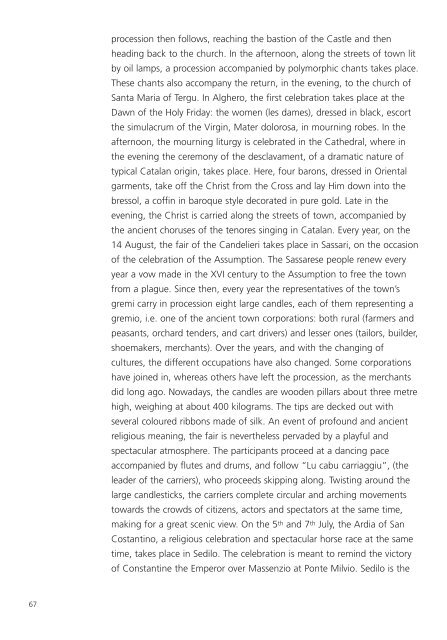Create successful ePaper yourself
Turn your PDF publications into a flip-book with our unique Google optimized e-Paper software.
procession then follows, reaching the bastion of the Castle and then<br />
heading back to the church. In the afternoon, along the streets of town lit<br />
by oil lamps, a procession accompanied by polymorphic chants takes place.<br />
These chants also accompany the return, in the evening, to the church of<br />
Santa Maria of Tergu. In Alghero, the first celebration takes place at the<br />
Dawn of the Holy Friday: the women (les dames), dressed in black, escort<br />
the simulacrum of the Virgin, Mater dolorosa, in mourning robes. In the<br />
afternoon, the mourning liturgy is celebrated in the Cathedral, where in<br />
the evening the ceremony of the desclavament, of a dramatic nature of<br />
typical Catalan origin, takes place. Here, four barons, dressed in Oriental<br />
garments, take off the Christ from the Cross and lay Him down into the<br />
bressol, a coffin in baroque style decorated in pure gold. Late in the<br />
evening, the Christ is carried along the streets of town, accompanied by<br />
the ancient choruses of the tenores singing in Catalan. Every year, on the<br />
14 August, the fair of the Candelieri takes place in Sassari, on the occasion<br />
of the celebration of the Assumption. The Sassarese people renew every<br />
year a vow made in the XVI century to the Assumption to free the town<br />
from a plague. Since then, every year the representatives of the town’s<br />
gremi carry in procession eight large candles, each of them representing a<br />
gremio, i.e. one of the ancient town corporations: both rural (farmers and<br />
peasants, orchard tenders, and cart drivers) and lesser ones (tailors, builder,<br />
shoemakers, merchants). Over the years, and with the changing of<br />
cultures, the different occupations have also changed. Some corporations<br />
have joined in, whereas others have left the procession, as the merchants<br />
did long ago. Nowadays, the candles are wooden pillars about three metre<br />
high, weighing at about 400 kilograms. The tips are decked out with<br />
several coloured ribbons made of silk. An event of profound and ancient<br />
religious meaning, the fair is nevertheless pervaded by a playful and<br />
spectacular atmosphere. The participants proceed at a dancing pace<br />
accompanied by flutes and drums, and follow “Lu cabu carriaggiu”, (the<br />
leader of the carriers), who proceeds skipping along. Twisting around the<br />
large candlesticks, the carriers complete circular and arching movements<br />
towards the crowds of citizens, actors and spectators at the same time,<br />
making for a great scenic view. On the 5 th and 7 th July, the Ardia of San<br />
Costantino, a religious celebration and spectacular horse race at the same<br />
time, takes place in Sedilo. The celebration is meant to remind the victory<br />
of Constantine the Emperor over Massenzio at Ponte Milvio. Sedilo is the<br />
67
















